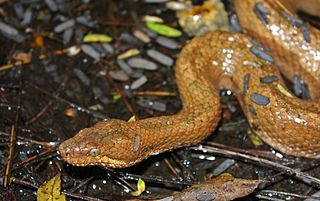
The Tropidophiidae, common name dwarf boas or thunder snakes, are a family of nonvenomous snakes found from Mexico and the West Indies south to southeastern Brazil. These are small to medium-sized fossorial snakes, some with beautiful and striking color patterns. Currently, two living genera, containing 34 species, are recognized. Two other genera were once considered to be tropidophiids but are now known to be more closely related to the boids, and are classified in the subfamily Ungaliophiinae. There are a relatively large number of fossil snakes that have been described as tropidophiids, but which of these are more closely related to Tropidophis and Trachyboa and which are more closely related to Ungaliophis and Exiliboa is unknown.

Tropidophis melanurus, commonly known as the dusky dwarf boa, Cuban wood snake, or Cuban giant dwarf boa, is a nonvenomous dwarf boa species found mainly in Cuba. There are three subspecies that are recognized as being valid, including the nominate subspecies described here.
Eryx elegans is a boa species endemic to western Central Asia. Like all other boas, it is not venomous. No subspecies are recognized.

The Round Island burrowing boa is an extinct species of snake, in the monotypic genus Bolyeria, in the family Bolyeriidae. The species, which was endemic to Mauritius, was last seen on Round Island in 1975. There are no recognized subspecies.

Tropidophis, common name wood snakes or West Indian wood snakes, is a genus of dwarf boas endemic to the West Indies and South America. Currently, either 17 or 33 species are recognized, depending on the authority.

Trachyboa is a genus of nonvenomous dwarf boas endemic to Central and South America. They are largely terrestrial, fish-eating snakes that inhabit tropical lowlands. Two species are recognized.
Tropidophis fuscus is a nonvenomous dwarf boa species endemic to Cuba. There are no subspecies that are recognized as being valid.
Tropidophis bucculentus, also known commonly as the Navassa Island dwarf boa, is a nonvenomous dwarf boa species endemic to Navassa Island in the Caribbean Sea. There are no subspecies that are recognized as being valid.
Tropidophis greenwayi is a nonvenomous dwarf boa species endemic to the Caicos Islands. Two subspecies are currently recognized, including the nominate subspecies described here.

The Bahamian pygmy boa constrictor, also known as the Inagua trope or Bahama wood snake, is a species of nonvenomous snake in the family Tropidophiidae. The species is endemic to Great Inagua Island in the Bahamas.
Tropidophis battersbyi, also known commonly as Battersby's dwarf boa and the Ecuadorian dwarf boa, is a species of snake in the family Tropidophiidae. The species is endemic to Ecuador.

Tropidophis feicki, also known commonly as the broad-banded dwarf boa, the broad-banded trope, and Feick's dwarf boa, is a species of non-venomous snake in the family Tropidophiidae. The species is endemic to Cuba.
Tropidophis haetianus, the Haitian dwarf boa, is a species of snake in the family Tropidophiidae. The species is endemic to the island of Hispaniola in the West Indies.
Tropidophis maculatus, or the spotted red dwarf boa, is a species of snake in the family Tropidophiidae. The species is endemic to Cuba.
Tropidophis nigriventis, or the black-bellied dwarf boa, is a species of snake in the family Tropidophiidae. The species is endemic to Cuba.
Tropidophis pardalis, also known commonly as the leopard dwarf boa and the spotted brown trope, is a species of snake in the family Tropidophiidae. The species is endemic to Cuba.
Tropidophis pilsbryi, commonly known as Pilsbry's dwarf boa or the Cuban white-necked dwarf boa, is a species of snake in the family Tropidophiidae. The species is endemic to Cuba.
Tropidophis wrighti, commonly known as Wright's dwarf boa, the gracile banded dwarf boa, and the gracile banded trope, is a species of snake in the family Tropidophiidae. The species is endemic to Cuba.
The seven-striped blind snake is a species of snake in the family Leptotyphlopidae. The species is native to northeastern South America.







